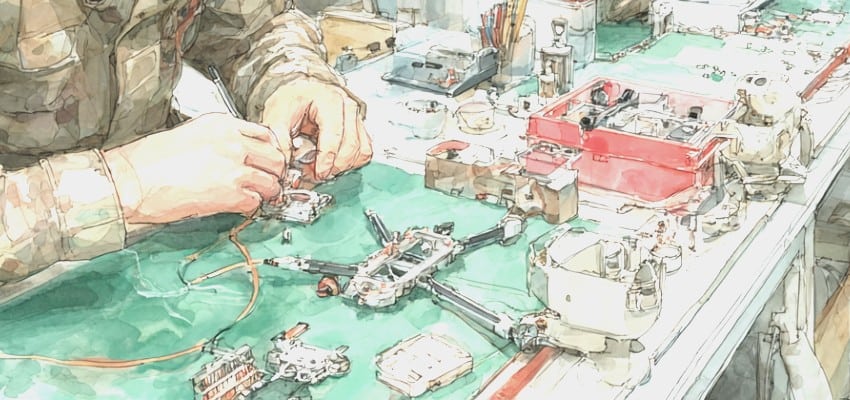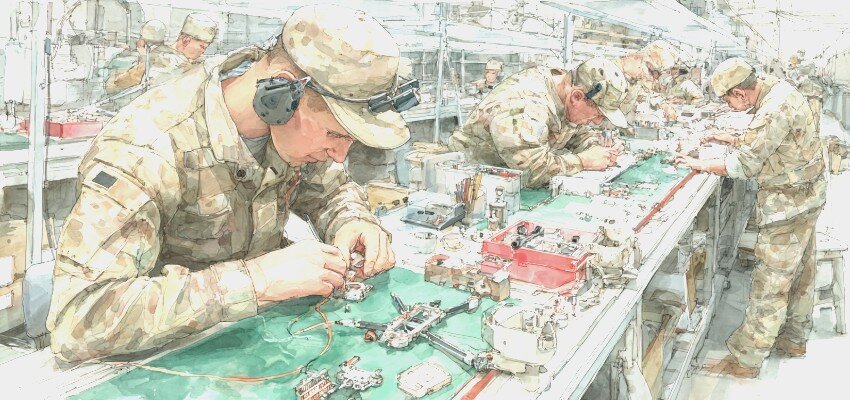Editor’s Note: This analysis draws from the Institute for the Study of War’s July 11, 2025, assessment, offering a precise examination of Ukraine’s evolving strategic posture amid ongoing Russian aggression. It highlights key developments including the U.S.-to-NATO arms transfer mechanism, Ukraine’s expanding drone and air defense capabilities, and the launch of the BraveTech EU Initiative as a pivotal step in European-Ukrainian defense-industrial integration. Set against the backdrop of a protracted war marked by attrition, this summary explores the operational significance of limited territorial advances, asymmetric strikes on Russian infrastructure, and the Kremlin’s continued control over the domestic information space.
For those seeking to grasp the full scope of this evolving landscape, the complete updates from the Institute for the Study of War serve as an invaluable resource.
Content Assessment: Industrial Innovation Meets Attritional Warfare: Ukraine’s BraveTech-Fueled Posture
Information - 94%
Insight - 93%
Relevance - 92%
Objectivity - 94%
Authority - 95%
94%
Excellent
A short percentage-based assessment of the qualitative benefit expressed as a percentage of positive reception of the recent article from ComplexDiscovery OÜ titled, "Industrial Innovation Meets Attritional Warfare: Ukraine’s BraveTech-Fueled Posture."
Background Note: ComplexDiscovery’s staff offers distinctive perspectives on the Russo-Ukrainian war and Middle Eastern conflicts, informed by their military experience on the West German, East German, and Czechoslovakian borders during the Cold War, as well as in Sinai as part of Camp David Accord compliance activities, during the timeframe of the Persian Gulf War. This firsthand regional knowledge has been further enhanced by recent staff travels to Eastern European countries, including Estonia, Finland, Latvia, Lithuania, and Poland. These visits have provided up-to-date, on-the-ground insights into the current geopolitical climate in regions directly impacted by the ongoing conflict.
Combined with cybersecurity, information governance, and eDiscovery proficiency, this multifaceted experience enables comprehensive analysis of these conflicts, including the critical impact of cyber warfare, disinformation, and digital forensics on modern military engagements. This unique background positions ComplexDiscovery to provide valuable insights for conflict-related investigations and litigation, where understanding the interplay of technology, data, and geopolitical factors is crucial.
Russo-Ukrainian Conflict Update*
Industrial Innovation Meets Attritional Warfare: Ukraine’s BraveTech-Fueled Posture
ComplexDiscovery Staff
In a marked departure from prior U.S. policy, President Donald Trump’s July 10 announcement of a U.S.-to-NATO arms sale—intended for Ukrainian transfer—represents a notable recalibration of Western military support to Kyiv. Trump confirmed that the United States will sell air defense systems, including the Patriot platform and interceptors, to NATO, which will subsequently supply these to Ukraine. While specific quantities remain undisclosed, Ukrainian President Volodymyr Zelensky has requested ten such systems, with Germany and Norway already signaling their readiness to procure several on Ukraine’s behalf.
Simultaneously, European nations are deepening their defense-industrial integration with Ukraine, highlighting the enduring transformation of Europe’s security architecture in response to Russia’s aggression. One such initiative—the BraveTech EU Initiative—marks a significant step in formalizing technological and industrial cooperation. Announced jointly by the European Commission and Ukraine’s Ministry of Digital Transformation, the BraveTech Initiative is designed to accelerate the innovation cycle within Europe’s defense industrial base (DIB) by incorporating Ukraine’s battle-tested technological capabilities and adaptive R&D culture. Scheduled to launch formally in Fall 2025, BraveTech will expand upon the European Defense Fund’s existing programs and facilitate operational synergy between Ukrainian defense manufacturers and European firms.
This initiative is not merely symbolic; it recognizes Ukraine’s frontline experience and its evolving expertise in unmanned systems, electronic warfare, and decentralized production models as assets to be embedded into Europe’s broader defense ecosystem. The BraveTech EU Initiative thus represents a pivotal inflection point in Ukraine’s integration into Western security frameworks, not only as a recipient of aid but as a co-developer of future-oriented defense technologies. This shift portends lasting changes to how NATO and the EU conceptualize collective defense and technological resilience.
Domestically, Ukraine continues to refine its response to Russia’s persistent aerial assaults. Kyiv’s Clean Sky program—a drone-based interceptor initiative—received a funding injection of ₴260 million (USD $6.2 million), establishing drone training centers and deploying mobile units. These units have reportedly downed over 650 Russian drones in Kyiv Oblast alone in recent months, underscoring their growing importance in Ukraine’s layered air defense architecture.
However, Patriot systems remain critical for countering ballistic missiles—capabilities currently beyond the reach of even Ukraine’s most advanced drone interceptors. This layered approach reflects a defensive strategy calibrated to neutralize Russia’s evolving long-range strike campaign, which continues to target both civilian and military infrastructure with Shahed-type drones and missiles. On the night of July 10–11, Russian forces launched 79 drones across Ukraine, with Kyiv and Odesa suffering significant infrastructural damage and civilian casualties.
On the battlefield, incremental gains and local reversals define the frontlines. In eastern Ukraine, Ukrainian and Russian forces exchanged control of territory around Kupyansk and Lyman. Ukrainian troops made modest progress east of Kindrashivka, while Russian forces advanced east of Petropavlivka and seized Zelena Dolyna, north of Lyman. Intense combat persists in these contested zones, where Russian advances remain slow and heavily attritional.
Farther south, Ukrainian forces conducted a limited counterattack near Novopavlivka, achieving marginal gains in western Novoserhiivka. Conversely, Russian troops reportedly advanced in the Toretsk direction, threatening Ukrainian defenses along the T-0516 highway. These gains remain unconfirmed, though geolocated footage supports Russian claims of minor progress northeast of Koptieve.
In northern Sumy Oblast, Russia has made a rare advance into Myropillia and reportedly pushed forward near Ryzhivka and Yunakivka. These movements, intended to create buffer zones and threaten Sumy City with artillery fire, signal a shift in Russia’s northern axis strategy. Ukrainian counteractions in this area were also reported, suggesting a fluid and reactive engagement pattern.
Ukraine’s strategic depth operations continue to inflict damage on Russia’s defense industrial base. A sabotage operation reportedly disrupted a critical gas pipeline supplying arms factories in Chelyabinsk, Orenburg, and Sverdlovsk. Simultaneously, drone strikes hit the Voronin Aviation Plant in Moscow Oblast and the Shipunov Instrument Design Bureau in Tula, both integral to Russian aerospace and missile development programs.
Despite these blows, Russia shows no sign of strategic recalibration. Lieutenant General Kyrylo Budanov, head of Ukraine’s GUR, judged Russia’s stated goal of seizing Donetsk Oblast by year-end as “not realistic.” This assessment aligns with ISW’s view: Russian forces, though persistent, lack the operational tempo or manpower to meet the Kremlin’s stated deadlines. The Economist further projected that, at current rates, Russia would not achieve full control of its claimed territories before 2028.
Amid this protracted conflict, the Kremlin continues to entrench its ideological grip domestically. Spokesperson Dmitry Peskov reaffirmed Russia’s justification for military censorship and the propagation of state “patriotic” media. This ongoing control over information is part of a broader Kremlin effort to codify a state ideology centered on nationalism, historical militarism, and hostility toward the West. These initiatives extend to educational reforms and youth militarization programs, ensuring long-term sociopolitical alignment with the regime’s wartime narrative.
Notably, Ukrainian forces struck a Rosgvardia military hub in occupied Melitopol, reportedly killing five personnel and destroying a satellite communications system. Further strikes targeted a train carrying Russian tanks between Tokmak and Chernihivka, destroying five of twenty units. These rear-area actions are emblematic of Ukraine’s hybrid strategy—combining attrition, disruption, and technological innovation to offset Russian numerical superiority.
The conflict has reached a phase defined by marginal tactical shifts, innovative asymmetric strikes, and an intensifying contest of wills. As Ukraine leverages Western defense partnerships, pan-European initiatives like BraveTech, and homegrown technologies, while Russia doubles down on long-range assaults and ideological consolidation, one must ask: will strategic attrition ultimately shift the momentum in Ukraine’s favor, or are both nations locked in a stalemate shaped more by endurance than decisive action?
Detailed Reporting with Maps for July 11, 2025, from the ISW – Mouseover to Scroll
Russo-Ukrainian War - July 11 2025 UpdateReview the Detailed Reporting and Maps PDF
About the Institute for the Study of War Research Methodology
ISW’s research methodology relies on both primary and secondary sources, enabling researchers to develop a comprehensive understanding of the situation on the ground. In order to analyze military and political developments in any given area, ISW’s research analysts must wholly understand the systems of enemy and friendly forces. They must also understand the population demographics, physical terrain, politics, and history of that area. This lays the analytical foundation for understanding the reasons for particular developments and fulfilling their assigned research objectives. ISW analysts also spend time in places like Iraq, Afghanistan, and elsewhere in order to gain a better understanding of the security and political situation and to evaluate the implementation of current strategies and policies. Their researchers compile data and analyze trends, producing a granular analysis of developments in areas of research, producing an accurate, high-resolution, timely, and thorough picture of the situation. ISW’s research methodology guarantees its success and commitment to improving the nation’s ability to execute military operations, achieve strategic objectives, and respond to emerging problems that may require the use of American military power.
About the Institute for the Study of War
The Institute for the Study of War advances an informed understanding of military affairs through reliable research, trusted analysis, and innovative education. They are committed to improving the nation’s ability to execute military operations and respond to emerging threats in order to achieve U.S. strategic objectives. ISW is a non-partisan, non-profit, public policy research organization.
Learn more, get involved, and contribute today.
Assisted by GAI and LLM Technologies
* Sourced and shared with direct expressed permission from the Institute for the Study of War (ISW).
Additional Reading
- From Dissent to OSINT? Understanding, Influencing, and Protecting Roles, Reputation, and Revenue
- Data Embassies: Sovereignty, Security, and Continuity for Nation-States
Source: ComplexDiscovery OÜ

























